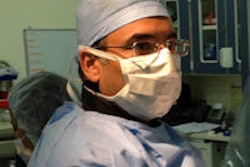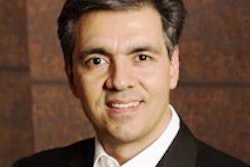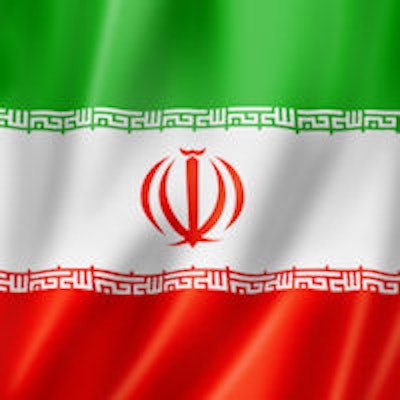
Radiologists in Iran have suffered through a series of economic body blows over the past three years, ranging from economic sanctions to currency collapse and misguided government policies. While the worst appears to be over, economic pressures continue to have a dramatic effect on Iranian radiologists.
That's according to a presentation by Dr. Mansoor Fatehi, general secretary of the Iranian Society of Radiology (ISR), at last month's ECR 2014. Fatehi gave ECR attendees an overview of the economic situation in Iran and how it has affected the quality of radiology services in the country over the past few years, presenting a report co-authored by Dr. Jalal Shokouhi, president of ISR, and Dr. Kourosh Abdollahifard, deputy for executive affairs at the society.
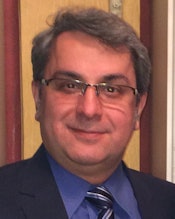 Dr. Mansoor Fatehi, general secretary of the Iranian Society of Radiology.
Dr. Mansoor Fatehi, general secretary of the Iranian Society of Radiology.
The report doesn't paint a pretty picture, revealing an environment in which reimbursement is cut in half, imaging studies are printed on plain paper and laminated, and radiology facilities are forced to double their procedure volume to pay for imported equipment. Fatehi's hope is that the report will raise awareness of Iran's situation, and illustrate the need to decouple politics from healthcare in international disputes.
A dramatic impact on healthcare
Fatehi told AuntMinnie.com that economic sanctions have dramatically affected healthcare in Iran, even though it's been claimed that sanctions excluded the medical sector. This has led to an urgent need for physicians to inform the international community about the situation.
"When I got the invitation to speak at ECR 2014 and the themes included economic issues and 'radiology in austerity,' I showed an interest in delivering this report," he said.
Fatehi noted in his ECR presentation that since 2010 there has been a dramatic change in the exchange rate between the Iranian rial (RI) and the U.S. dollar. While $1 was equal to RI 11,000 in 2010, the rate increased to RI 33,000 in 2012, resulting in the Iranian currency losing two-thirds of its purchasing power -- a development that affected multiple aspects of people's daily lives. For example, while Iran's minimum salary was equal to $275 in 2010, it dropped to $119 in 2012 before going back up to $162 in 2013, he explained.
Although the fee for a chest x-ray has been rising since 2010 in rials, when that same fee is converted into dollars it has actually been cut in half, from $2.90 in 2010 to $1.40 in 2012, Fatehi noted. Also, the fee for a female pelvic ultrasound scan plummeted from $4.30 in 2010 to $2.10 in 2013. Similar declines were seen in fees charged for brain CT and lumbosacral MRI.
These factors have put great economic burden on radiology departments, Fatehi explained. Generally, fees dropped from 2010 to 2012, followed by a slight uptick in 2013, but it wasn't enough to recover the decline that had occurred since 2010.
Lagging its neighbors
Fatehi further illustrated the severity of the situation by comparing fees charged in Iran for standard imaging procedures with what's charged in neighboring countries.
While a standard chest x-ray in Iran cost $2 in 2013, in neighboring Iraq it was $16. In Turkey the cost was $6 and in Afghanistan it was $5.50, while in Pakistan the cost was $7. The situation is similar for head CT and lumbosacral MRI, where there was a significant difference in fees between Iran and its neighbors. The average fee for lumbosacral MRI was $20.10 in Iran, $151 in Iraq, $103 in Afghanistan, $36 in Turkey, and $60 in Pakistan.
When Fatehi compared fees charged in Iran with those in some Western countries, the divide was even more substantial. For example, the fee charged for head CT in Iran is $9.80, compared with $235 in the U.S. and $200 in Germany. A similar trend is observed for other imaging procedures. (Fatehi emphasized that the figures he used are not official ones but approximations and averages collected from colleagues in other countries.)
The problem, he pointed out, is that Iranian hospitals are paying the same price -- if not more -- than other countries to acquire the imported medical imaging equipment used for these procedures, while getting rock-bottom payments.
The price of a 3D/4D ultrasound scanner in 2010, for example, was 100 million tomans (1 toman = 10 rials), equaling approximately $39,000; due to currency changes, this more than doubled to 250 million tomans in 2012, putting the price of the same system at about $98,000, he explained.
As a result, radiology departments came under tremendous operational pressure: To recoup their investment in an ultrasound scanner, they had to perform 21,000 pelvic ultrasound scans in 2010, a number that more than doubled to 50,000 scans in 2012.
Likewise, the price of helium for MRI scanners increased significantly between 2010 and 2012. Film and IT hardware such as servers, monitors, and PACS all also saw price hikes.
Laminated images
This kind of economic pressure has had a major effect on all aspects of Iranian radiology departments, Fatehi said. It negatively affects the quality of interpretation, calibration, education, and procedures, and it leads to dissatisfied radiologists, technologists, physicians, patients, and staff.
Also, departments stagnate because they are unable to upgrade equipment due to lack of funds, and the pressures trigger ethical issues such as a growing black market and self-referrals among departments. Paper printing of medical images is another side effect of the situation. In his ECR talk, Fatehi showed an image of a paper printer and explained that radiologists cannot afford film, so they print images on paper and laminate them.
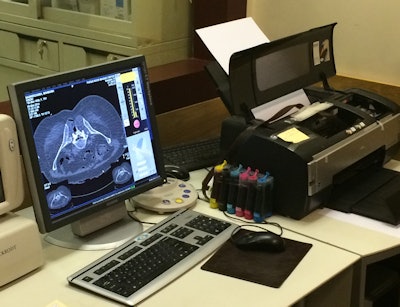 Radiologists print images on paper due to lack of resources. Image courtesy of Dr. Mansoor Fatehi.
Radiologists print images on paper due to lack of resources. Image courtesy of Dr. Mansoor Fatehi.International sanctions and the Iranian government's policy on subsidies have further compounded the problem. Just before the international sanctions took effect, the government implemented a gradual reduction of subsidies, which raised the cost of utilities and petroleum and affected all aspects of life. The international sanctions then brought further problems, including issues with importing, transporting, insurance, money transfer, and export licenses, along with the rise of the black market, he explained.
What to do
To alleviate the situation, Fatehi called for national and international support teams and for vendors to show flexibility with countries in Iran's particular situation.
"We should take away the issue of politics from health, and ordinary people should not have to suffer," he said.
The situation in Iran has led to hopelessness among young radiologists as they face significant financial problems in establishing and running new imaging centers, Fatehi told AuntMinnie.com. It has also affected patients because the cash-strapped government has no money to pay insurance organizations, which are then unable to reimburse hospitals and clinics, he said.
Patients, therefore, have to shoulder an increasing part of their care out of pocket because clinics can't survive if they're not sure when insurance companies will reimburse them.
"On one side, the cost of imaging services has risen dramatically, and on the other side, people cannot pay for more expensive imaging services," he said. "So we cannot increase fees as much as expected from the rise in our costs."
Fatehi said he received tremendous feedback from his ECR talk, where it was called an "eye opener," "shocking," and an "honest report." Iranian radiologists who attended the session congratulated him for drawing attention to their situation in the international community.
"My report will have a national impact as well, and we are going to publish and present it in medical council meetings and media as well as to Ministry of Health officials," he said.
He stressed that there should be international rules and regulations to avoid crises in the healthcare industry in times of political turmoil.
"The vendors need to have more humane policies to accommodate these dramatic changes in economy," he said. "Medical device vendors should realize that they are different from car or home appliance companies, and when a country with a hot market and big medical community faces such a specific dramatic problem, they should be accommodating."
Despite all of the challenges, Fatehi expressed hope for the future.
"The new [government in Iran] has a more realistic approach to [domestic] politics and the economy, as well as international politics," he told AuntMinnie.com. "The people, including medical professionals, feel more hopeful these days, and although the problem has not yet been solved, the trends are promising."






